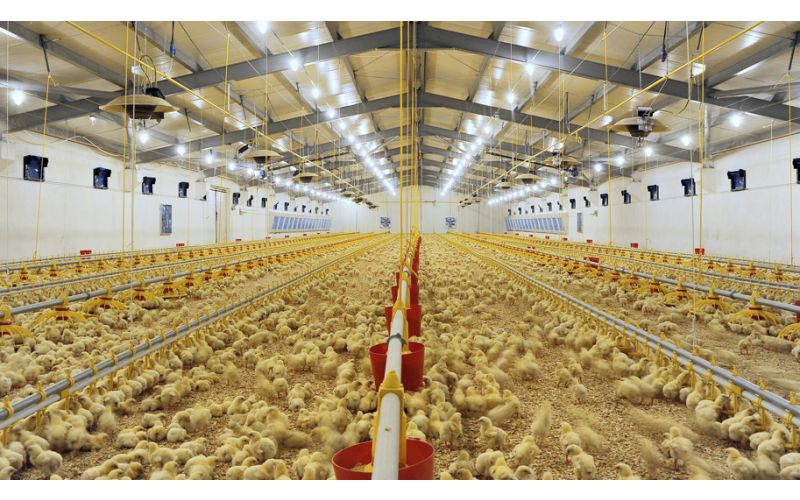
Shedding Light on Efficiency: The Benefits of LED Lighting in Poultry Production
|
|
Time to read 5 min
 You are being redirected to QC Supply Pharmacy, where you’ll find a wide selection of high-quality prescription and pharmaceutical products for animals of all sizes.
Enjoy the same great service and expertise you trust from QC Supply.
Click below to continue shopping.
Continue
No thanks, stay on the main site
Powered by
You are being redirected to QC Supply Pharmacy, where you’ll find a wide selection of high-quality prescription and pharmaceutical products for animals of all sizes.
Enjoy the same great service and expertise you trust from QC Supply.
Click below to continue shopping.
Continue
No thanks, stay on the main site
Powered by


|
|
Time to read 5 min
Proper lighting is a key component of any poultry facility. In the last ten years, Light-Emitting Diode (LED lighting in poultry production), often called poultry farm LED lights) has become a financially realistic alternative to incandescent and compact fluorescent (CFL) lighting.
In the past couple of years, studies have looked at the LED lighting cost effectiveness of the typically more expensive LED lights for commercial poultry lighting solutions, especially when aiming for energy-efficient poultry lighting. The future of LED poultry lighting benefits is bright.
Using LED lights (including LED lighting for chicken houses) increases productivity and allows you to recoup the initial costs in the form of substantially lower lighting bills, showcasing significant cost savings with LED lighting compared to older systems.
Compared to incandescent bulbs, LED lighting can save poultry producers something in the vicinity of 80-85 percent on their electric bill. Maximum savings occur when whole poultry barn lighting systems lighting systems are replaced. Partial system replacement or replacing individual bulbs will not provide appreciable savings—the savings comes from large-scale replacement.
For example, for an initial cost of $800 to $2000, a producer can expect to save $1,200 to $1,400 per year by replacing 52 75-watt incandescent bulbs with 52 10-watt LED bulbs. A substantial savings for farmers. After one year, the upfront cost is nearly, if not all, paid for. The savings are mainly due to the long life of LED bulbs and the fewer watts needed to power the bulbs. Consumer Reports notes that LED bulbs can last from between 20,000 to 50,000 hours, about five times longer than any other bulb on the market. Now that LED bulbs are available, generally, between $5-$8 apiece, the upfront cost in replacing a lighting system is much lower than it would have been, even a few years ago.
For a relatively small upfront cost, LED lights provide you with extremely long-lasting, dimmable, and efficient lights (that are mercury-free poultry lighting options, unlike CFLs). The costs of LED bulbs are only getting more competitive compared with CFLs.
For poultry facilities, light intensity counts most on the floor, at bird-level. Light intensity, in the US, is measured in lumens of output. Foot-candles (fc) are the number of lumens per square foot. Because LED lighting is directional, a 500 lumen bulb will produce, generally speaking, a comparable fc reading to a non-directional 1500 lumen bulb. When comparing which LED bulbs to install, you’ll want to compare the lumens and foot-candles in poultry lighting at bird-level. All lights will lose intensity over time, but LED lights have a significantly lower LED lighting depreciation rates compared with other bulbs—about 2-5 percent/year compared with 12-15 percent/year with CFLs and 25-40 percent/year with incandescent bulbs.
Selecting the right LED bulb for your production facility is important. The safest decision is to do some research to find out what brands other poultry producers are using. Home- or commercial-grade LED bulbs may not be appropriate for your chicken facility because of the moisture, humidity, dust, and ammonia typically found there. Any bulb selected should be able to withstand these types of environmental conditions.
Both Energy Star and Lighting Design Labs-LM79 provide certifications. This ensures the LED was tested independently and has not failed any certification requirement. A minimum bulb-choice criteria would be to check your desired bulbs' certification.
Bulbs should be able to provide adequate foot-candle intensity for newborn chicks at floor-level (2+ fc), but also to be dimmed to meet adult flock needs. Not all dimmers work well with all LED bulbs. This may be in part because dimmer technology has not kept up with the advancements in LED technology.
Most old incandescent bulbs dim linearly—meaning that if you lower the dimmer halfway, your incandescent bulb will be half as bright. LED bulbs do not dim linearly and you may need to lower the dimmer significantly before the LED bulb actually dims at all, and then it may dim dramatically. Most LEDs should dim as you expect them to with new dimmers. Dimmer technology is catching up, and there are now LED-specific dimmers available, but there are also many older models still on the market and in use that are not wholly compatible with LEDs.
Over time, excessive heat will cause a decrease in bulb efficiency. Some LED lights have metal or plastic fins to aid heat reduction. In poultry houses, however, these fins can get dirty leading to a shorter bulb life due to dirt and the resulting heat buildup. It’s always a smart idea to clean your bulbs—an ammonia and water solution works well— particularly in a production facility. Clean bulbs are the most efficient and long-lasting bulbs, leading to maximum savings.
One area of speculation with regard to LED vs incandescent lighting in farms, or even LED vs. CFLs, concerns flickering. Some studies note that producers observed an overall increased flock calmness with LED lights because, it is suspected, they do not flicker the way CFL bulbs will. Because chickens have extremely sensitive eyesight, it is thought that the reduced flicker of LED bulbs was the cause of the calming effect.
It is also recommended to exercise caution with claims of increased performance based only on light color. While it is widely known that light color affects chicken behavior and performance, the science of such claims, particularly with LED lights in the 3000°-5000° Kelvin range, is still not definitive. Most LED lights range between 3000°-5000° K with a 3000° K light producing a yellow-white appearance and a 5000° K light producing a cool white light.
That said, a 2013 Brazilian study in Journal of Applied Poultry Research indicated that birds raised with LED lighting performed better than those with CFL lighting. Seven-day-old male broilers were found to have a better feed conversion with LED lights compared with those reared with CFL lights. Additionally, birds raised with white LED lighting showed increase feed consumption than those raised with an even mix of yellow and white LED lighting.
One certain thing, however, is that LED lights are becoming more and more popular because of their efficiency, something that will only increase as the cost per bulb decreases. Considering the substantial savings associated with large-scale LED use, it may make sense for you to switch to LEDs in your poultry facility.
Learn more about how to care for your barn and animals:
Do you use LED lighting for your chickens? Tell us your experience in the comments section!